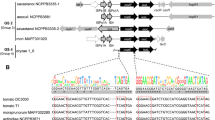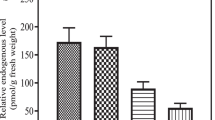Abstract
Plants produce a wide array of antimicrobial compounds, such as phenolic compounds, to combat microbial pathogens. The hrp PAI is one of the major virulence factors in the plant pathogen, Pseudomonas syringae. A major role of hrp PAI is to disable the plant defense system during bacterial invasion. We examined the influence of phenolic compounds on hrp PAI gene expression at low and high concentrations. There was approximately 2.5 times more hrpA and hrpZ mRNA in PtoDC3000 that was grown in minimal media (MM) supplemented with 10 -M of ortho-coumaric acid than in PtoDC3000 grown in MM alone. On the other hand, a significantly lower amount of hrpA mRNA was observed in bacteria grown in MM supplemented with a high concentration of phenolic compounds. To determine the regulation pathway for hrp PAI gene expression, we performed qRTPCR using gacS, gacA, and hrpS deletion mutants.
Similar content being viewed by others
References
Alfano, J.R., Charkowski, A.O., Deng, W.L., Badel, J.L., Petnicki-Ocwieja, T., van Dijk, K., and Collmer, A. 2000. The Pseudomonas syringae Hrp pathogenicity island has a tripartite mosaic structure composed of a cluster of type III secretion genes bounded by exchangeable effector and conserved effector loci that contribute to parasitic fitness and pathogenicity in plants. Proc. Natl. Acad. Sci. USA 97, 4856–4861.
Bretz, J., Losada, L., Lisboa, K., and Hutcheson, S.W. 2002. Lon protease functions as a negative regulator of type III protein secretion in Pseudomonas syringae. Mol. Microbiol. 45, 397–409.
Buell, C.R., Joardar, V., Lindeberg, M., Selengut, J., Paulsen, I.T., Gwinn, M.L., Dodson, R.J., Deboy, R.T., Durkin, A.S., Kolonay, J.F., et al. 2003. The complete genome sequence of the Arabidopsis and tomato pathogen Pseudomonas syringae pv. tomato DC3000. Proc. Natl. Acad. Sci. USA 100, 10181–10186.
Cha, J.Y., Lee, D.G., Lee, J.S., Oh, J.I., and Baik, H.S. 2012. GacA directly regulates expression of several virulence genes in Pseudomonas syringae pv. tabaci 11528. Biochem. Biophys. Res. Commun. 417, 665–672.
Cha, J.Y., Lee, J.S., Oh, J.I., Choi, J.W., and Baik, H.S. 2008. Functional analysis of the role of Fur in the virulence of Pseudomonas syringae pv. tabaci 11528: Fur controls expression of genes involved in quorum-sensing. Biochem. Biophys. Res. Commun. 366, 281–287.
Chatterjee, A., Cui, Y., Yang, H., Collmer, A., Alfano, J.R., and Chatterjee, A.K. 2003. GacA, the response regulator of a twocomponent system, acts as a master regulator in Pseudomonas syringae pv. tomato DC3000 by controlling regulatory RNA, transcriptional activators, and alternate sigma factors. Mol. Plant-Microbe Interact. 16, 1106–1117.
Collmer, A., Badel, J.L., Charkowski, A.O., Deng, W.L., Fouts, D.E., Ramos, A.R., Rehm, A.H., Anderson, D.M., Schneewind, O., van Dijk, K., et al. 2000. Pseudomonas syringae Hrp type III secretion system and effector proteins. Proc. Natl. Acad. Sci. USA 97, 8770–8777.
Durrant, W.E. and Dong, X. 2004. Systemic acquired resistance. Annu. Rev. Phytopathol. 42, 185–209.
Fouts, D.E., Abramovitch, R.B., Alfano, J.R., Baldo, A.M., Buell, C.R., Cartinhour, S., Chatterjee, A.K., D'Ascenzo, M., Gwinn, M.L., Lazarowitz, S.G., et al. 2002. Genomewide identification of Pseudomonas syringae pv. tomato DC3000 promoters controlled by the HrpL alternative sigma factor. Proc. Natl. Acad. Sci. USA 99, 2275–2280.
Galan, J.E. and Collmer, A. 1999. Type III secretion machines: bacterial devices for protein delivery into host cells. Science 284, 1322–1328.
Grimm, C., Aufsatz, W., and Panopoulos, N.J. 1995. The hrpRS locus of Pseudomonas syringae pv. phaseolicola constitutes a complex regulatory unit. Mol. Microbiol. 15, 155–165.
Heeb, S. and Haas, D. 2001. Regulatory roles of the GacS/GacA twocomponent system in plant-associated and other Gram-negative bacteria. Mol. Plant-Microbe Interact. 14, 1351–1363.
Hendrickson, E.L., Guevera, P., and Ausubel, F.M. 2000. The alternative sigma factor RpoN is required for hrp activity in Pseudomonas syringae pv. maculicola and acts at the level of hrpL transcription. J. Bacteriol. 182, 3508–3516.
Hutcheson, S.W., Bretz, J., Sussan, T., Jin, S., and Pak, K. 2001. Enhancer-binding proteins HrpR and HrpS interact to regulate hrp-encoded type III protein secretion in Pseudomonas syringae strains. J. Bacteriol. 183, 5589–5598.
Lee, H.I., Leon, J., and Raskin, I. 1995. Biosynthesis and metabolism of salicylic acid. Proc. Natl. Acad. Sci. USA 92, 4076–4079.
Lenz, O., Schwartz, E., Dernedde, J., Eitinger, M., and Friedrich, B. 1994. The Alcaligenes eutrophus H16 hoxX gene participates in hydrogenase regulation. J. Bacteriol. 176, 4385–4393.
Lindgren, P.B. 1997. The role of hrp genes during plant-bacterial interactions. Ann. Rev. Phytopathol. 35, 129–152.
MacLean, D. and Studholme, D.J. 2010. A boolean model of the Pseudomonas syringae hrp regulon predicts a tightly regulated system. PLoS One 5, e9101.
Montesano, M., Brader, G., Ponce, D.E.L.I., and Palva, E.T. 2005. Multiple defence signals induced by Erwinia carotovora ssp. carotovora elicitors in potato. Mol. Plant Pathol. 6, 541–549.
Pfaffl, M.W. 2001. A new mathematical model for relative quantification in real-time RT-PCR. Nucleic Acids Res. 29, e45.
Ravirala, R.S., Barabote, R.D., Wheeler, D.M., Reverchon, S., Tatum, O., Malouf, J., Liu, H., Pritchard, L., Hedley, P.E., Birch, P.R., et al. 2007. Efflux pump gene expression in Erwinia chrysanthemi is induced by exposure to phenolic acids. Mol. Plant-Microbe Interact. 20, 313–320.
Ryals, J.A., Neuenschwander, U.H., Willits, M.G., Molina, A., Steiner, H.Y., and Hunt, M.D. 1996. Systemic acquired resistance. Plant Cell 8, 1809–1819.
Sambrook, J. and Russell, D.W. 2001. Molecular Cloning: a laboratory manual, third ed. Cold Spring Harbor, New York, USA.
Simon, R., Priefer, U., and Puhler, A. 1983. A broad host range mobilization system for in vivo genetic-engineering - transposon mutagenesis in Gram-negative bacteria. Bio-Technol. 1, 784–791.
Sticher, L., Mauch-Mani, B., and Metraux, J.P. 1997. Systemic acquired resistance. Ann. Rev. Phytopathol. 35, 235–270.
Wei, W., Plovanich-Jones, A., Deng, W.L., Jin, Q.L., Collmer, A., Huang, H.C., and He, S.Y. 2000. The gene coding for the Hrp pilus structural protein is required for type III secretion of Hrp and Avr proteins in Pseudomonas syringae pv. tomato. Proc. Natl. Acad. Sci. USA 97, 2247–2252.
Xiao, Y., Heu, S., Yi, J., Lu, Y., and Hutcheson, S.W. 1994. Identification of a putative alternate sigma factor and characterization of a multicomponent regulatory cascade controlling the expression of Pseudomonas syringae pv. syringae Pss61 hrp and hrmA genes. J. Bacteriol. 176, 1025–1036.
Yang, H.J., Lee, J.S., Cha, J.Y., and Baik, H.S. 2011. Negative regulation of pathogenesis in Pseudomonas syringae pv. tabaci 11528 by ATP-dependent Lon protease. Mol. Cells 32, 317–323.
Yang, S., Peng, Q., San Francisco, M., Wang, Y., Zeng, Q., and Yang, C.H. 2008. Type III secretion system genes of Dickeya dadantii 3937 are induced by plant phenolic acids. PLoS One 3, e2973.
Author information
Authors and Affiliations
Corresponding author
Additional information
These authors contributed equally to this study.
Rights and permissions
About this article
Cite this article
Lee, J.S., Ryu, H.R., Cha, J.Y. et al. The hrp pathogenicity island of Pseudomonas syringae pv. tomato DC3000 is induced by plant phenolic acids. J Microbiol. 53, 725–731 (2015). https://doi.org/10.1007/s12275-015-5256-4
Received:
Revised:
Accepted:
Published:
Issue Date:
DOI: https://doi.org/10.1007/s12275-015-5256-4




